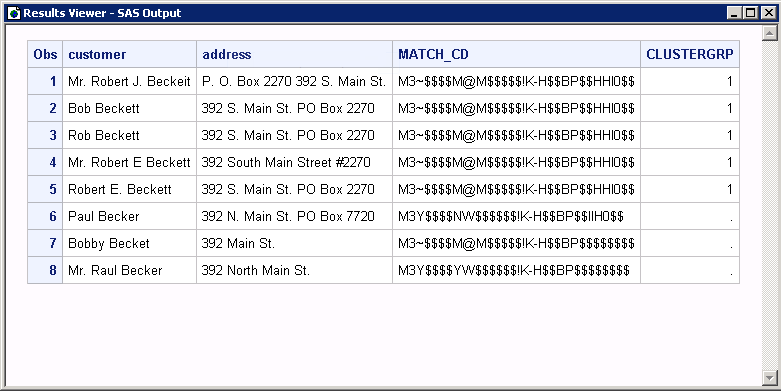DQMATCH Procedure
Example 1: Generate Composite Match Codes
The following example
uses the DQMATCH procedure to create composite match codes and cluster
numbers. The default sensitivity level of 85 is used in both CRITERIA
statements. The locale ENUSA is assumed to have been loaded into memory
previously with the %DQLOAD AUTOCALL macro.
/* Create the input data set. */ data cust_db; length customer $ 22; length address $ 31; input customer $char22. address $char31.; datalines; Bob Beckett 392 S. Main St. PO Box 2270 Robert E. Beckett 392 S. Main St. PO Box 2270 Rob Beckett 392 S. Main St. PO Box 2270 Paul Becker 392 N. Main St. PO Box 7720 Bobby Becket 392 Main St. Mr. Robert J. Beckeit P. O. Box 2270 392 S. Main St. Mr. Robert E Beckett 392 South Main Street #2270 Mr. Raul Becker 392 North Main St. ; run; /* Run the DQMATCH procedure. */ proc dqmatch data=cust_db out=out_db1 matchcode=match_cd cluster=clustergrp locale='ENUSA'; criteria matchdef='Name' var=customer; criteria matchdef='Address' var=address; run; /* Print the results. */ proc print data=out_db1; run;
Details
The output data set,
OUT_DB1, includes the new variables MATCH_CD and CLUSTERGRP. The MATCH_CD
variable contains the composite match code that represents both the
customer name and address. Because the default argument DELIMITER
was used, the resulting match code contains two match code components
(one from each CRITERIA statement) that are separated by an exclamation
point.
The CLUSTERGRP variable
contains values that indicate that five of the character values are
grouped in a single cluster and that the other three are not part
of a cluster. The clustering is based on the values of the MATCH_CD
variable. By looking at the values for MATCH_CD, you can see that
five character values have identical match code values. Although the
match code value for customer Bobby Becket is similar to the Cluster
1 match codes, the address difference caused it to be excluded in
Cluster 1.
Matching Values Using Mixed Sensitivity Levels shows how the use of non-default sensitivity levels increases
the accuracy of the analysis.

